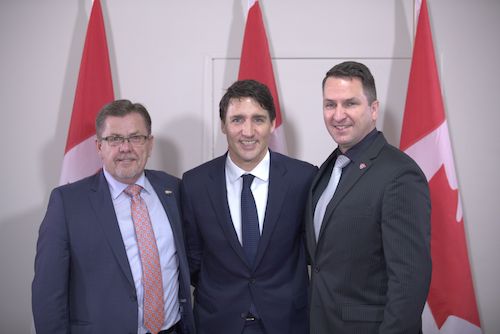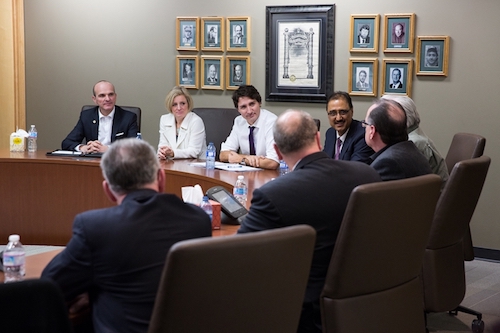Toronto Local 353 Vice President Jeff Irons views the upcoming Canadian federal elections much like an organizing drive.
There’s been plenty of outreach to members – much like there is to potential members during an organizing campaign – telling them what’s at stake and encouraging them to vote.
Irons and Business Manager Steven Martin won’t tell members how to vote when Canadians go to their ridings polls on Oct. 21. But they’re convinced that if IBEW and other union members show up in force, it will lead to good things for Canada’s working families.

|
| Canadian Prime Minister Justin Trudeau, center, stands with First District Vice President Thomas Reid, left, and Matthew Wayland, Reid’s executive assistant and the IBEW’s director of governmental affairs in Canada. Trudeau recently named Wayland to a committee that will advise the prime minister’s office on promoting apprenticeships and the skilled trades.
|
“It comes down to member education,” Irons said. “It’s one-on-one conversations.”
Prime Minister Justin Trudeau’s Liberal government, which won a majority in 2015, will try to stay in control, but it won’t be easy. The Conservative Party or its allies took over provincial assemblies from the New Democratic Party in Alberta and the Liberals in Ontario during the last year.
As of October 7, CBC’s Poll Tracker gave the Liberals a 39% chance of winning a majority and a 30% chance of winning the most seats but not a majority, which would force it to form a coalition government. Conservatives were given a 24% chance of winning the most seats but not a majority and a 7% chance of winning a majority.
“We never tell anyone what to do,” Irons said. “Union members are smart, type-A people and we don’t like to be told what to do. But I do tell them what the issues are and who shares our values.”
In many ridings, that means the most pro-worker candidate is usually – but not always – from the ruling Liberals.
In some ridings, it could mean the NDP candidate – such as Winnipeg’s Elmwood-Transcona, where Winnipeg, Manitoba, Local 2085 and NDP member Daniel Blaikie is running a close race for re-election to Parliament. The NDP is expected to lose seats overall but still might form a coalition government along with the Liberals.
But Martin and Irons both noted the IBEW and other unions had virtually no access to the levers of power when the Conservatives were in charge for nearly 10 years before the Liberals triumphed in 2015. Those 10 years under the Conservatives resulted in an assault on organized labour and workers’ rights and an increase in income inequality.
That’s changed during the last four years. The IBEW now has a seat at the table and Trudeau and the Liberals have followed through on many of the pro-worker polices they promised, including:
- Reversed bills C-377 and C-525 – a pair of anti-union bills pushed by Conservatives that placed onerous reporting requirements on unions and made organizing new workers more burdensome.
- Expanded the Canada Pension Plan and increased the Guaranteed Income for the country’s poorest senior citizens.
- Prohibited the presence in construction materials of asbestos, a carcinogen known for decades to cause cancer. The previous Conservative government resisted efforts to do so.
- Reduced the employment insurance waiting period from two weeks to one.
- Created a Just Transition Task Force to reduce the impacts of the move away from coal-fired power generation on those workers and their communities.
- Created the advisory council on the implementation of National Pharmacare. This led to a national dialogue on how to implement an affordable pharmacare plan for Canadians and their families, employers and governments.
Nearly 2,000 miles from Toronto near the Pacific Ocean, the goal is the same but the path to reaching it is different for Vancouver, British Columbia, Local 213 Business Manager Jim Lofty.
Local 213 and most unions have a very good relationship with the NDP, which controls the provincial government, Lofty said. But with the NDP expected to do poorly on the national level, he’s advising his members to strongly consider the Liberal candidate if it looks like the NDP candidate in their riding has little chance to win.

|
| Trudeau meets with IBEW and other officials from the building trades in western Canada during his visit to Local 424 in February 2016. Then-Alberta Premier Rachel Notley is to Trudeau’s right.
|
“Given the climate of this election, we have to tell our members that while we won’t tell you how to vote, you’re going to make it harder for us to do our job and to defend you if you vote Conservative,” he said.
“We’re telling them to remember what it was like when [former Conservative Prime Minister Stephen Harper, who was notoriously anti-union] was here,” Lofty added. “We’re trying to bring back those memories.”
Like Irons, Lofty is concerned the Conservatives will reopen the Canadian constitution if they win a majority of the provincial governments and a majority in Parliament. That could lead to more draconian proposals than under Harper.
“If you’re looking to support the people that support labor and working people and the middle class, don’t be distracted by the rhetoric around gun control and immigration,” Lofty said.
The IBEW’s access to the Trudeau government was on display in the days leading up to the election. Matthew Wayland, the director of governmental relations in Canada and an executive assistant to First District Vice President Thomas Reid, was recently named to a newly formed three-person committee that will advise the prime minister on promoting apprenticeships and the skilled trades. The IBEW and other trades likely would be frozen out of such a committee under a Conservative government – if one was formed at all.
“Canadians count on tradespeople every day,” Trudeau said when announcing the committee. “They power our industry, keep our vehicles and public transit moving and build the places we call home. By promoting in-demand careers in the trades, we can help more young people find good, well-paying jobs and build a stronger economy for the benefit of all Canadians.”
Like Lofty, Martin is encouraging members to concentrate on that rather than the anti-immigrant, protectionist rhetoric coming from Conservative leader Andrew Scheer, who seems to be taking a page from U.S. President Donald Trump’s playbook.
That strategy is to highlight divisive themes that might appeal to working families while doing little that actually supports them.
“People sometimes come out of the woodwork and vote in a protectionist mode and think politicians are helping them when they are actually doing nothing of the sort,’’ Martin said.
Plus, as Martin pointed out, newly-elected governments that displaced the worker-friendly assemblies in Alberta and Ontario made it a priority to turn back initiatives that have supported working families.
In Alberta, the ruling Progressive Conservative Party has formed a corporate-dominated committee that will study rolling back the province’s $15 minimum wage.
In Ontario, the ruling Conservative Party and Premier Doug Ford tried to force cities in the province to do away with agreements that would prioritize bids from union contractors on public infrastructure projects. Those agreements guarantee a high quality of work for taxpayers, a living wage for workers and training opportunities for apprentices.
“You’ll sometimes hear people say it doesn’t matter who gets elected,” Irons said. “That’s easy to say, but it’s not true. The Trudeau government has done some good things for Canadian workers and we know what we’re going to get from a Conservative government.”
Canadians are eligible to vote if they are at least 18 years old on election day. Anyone eligible to vote should receive a voter information card in the next week. Voters can update their listing at the Elections Canada website, which also includes a list of acceptable forms of identification needed at the polls.
Voters who are unable to vote in their home riding on election day can vote at any Elections Canada office prior to Oct. 15 at 6 p.m. local time. They also can vote at their assigned polling station between Oct. 11-14, the Thanksgiving weekend. Voters wishing to vote by mail must apply by Oct. 15 to receive their voting kit and return it by election day.